The anarchist worker Costantino Quaglieri died on February 12th, 1895, three days before his twenty-second birthday while he was detained in Regina Coeli jail in Rome. According to the official version of the police headquarters the young man died of "voluntary strangulation", but immediately many people suspected a murder by the police.
Private
life
Costantino was born on February 15th, 1873 in Arpino,
at the time in the province of Terra di Lavoro, (also called Caserta),
currently in the province of Frosinone, to Domenico and Vincenza
Loreta Vallucci. He wasn't a member of any political group and,
besides working as a worker, he was a student of the Istituto
di Belle Arti (Institute of Fine Arts), the current
Accademia di Belle Arti (Academy of Fine Arts) of Rome,
where he was regularly awarded at the end of the academic year.
The protests
of the end of 1800s
At the end of the nineteenth century, the subaltern classes suffered
severe distress by unemployment, price increase and taxes rise.
Socialists, anarchists and republicans organized protests across
Italy, severely repressed. In 1882 Andrea
Costa was the first socialist to be elected to the Chamber
of Deputies, in 1892 the Italian Socialist Party and in 1895 the
Italian Republican Party were founded.
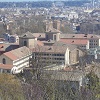
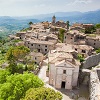
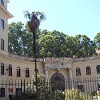

The bombs
of 1893
In the first months of 1893 more than a dozen bomb attacks took
place in the center of Rome, including one in the night between
13th and 14th February in front of the villa
of the right-wing senator Corrado
Tommasi Crudeli, in via Balbo (see news on Il
Messaggero and on the Vatican newspaper L'Osservatore
romano), and another on February 20th
in front of the house of the socialist deputy Enrico
Ferri in via Cavour, 57 (see news on Il
Messaggero). After a few days, on February 23rd,
the police arrested seven anarchists: Umberto Pagliai, Emilio
Pocorni, Michele Pulcini, Cesare Bensi, Domenico Fedeli, Raul
Santiangeli and Gualtiero De Angelis (see news on L'Osservatore
romano).The seven were accused of eight explosions occurred
from January 22nd. Later Carlo Celli, Temistocle
Monticelli, Giovanni Forbicini, Umberto Mancini, Alceo Latini,
Giuseppe Innocenzi, Tito Lubrano, Giacomo Moretti, Ernesto Emiliani,
Luigi Zecchini, Casimiro Chiocchini, Edoardo Orazi, Giuseppe Del
Bravo, Filippo Troia, Vincenzo Vittorio Orazi, Adriano Vincenzoni
and Emilio Paolini were arrested.
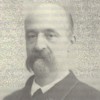
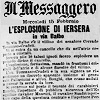
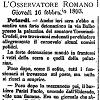
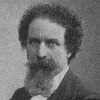
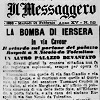
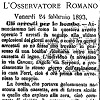
The Palermo
trial
Starting from the
end of 1893, the harsh living conditions of the subaltern classes
of Sicily generated the movements of the Fasci dei lavoratori
(Workers' Bundles), animated by laborers, sulfur miners, workers
and miners, inspired by socialist ideas, which suffered a blood-soaked
repression by the government leaded by the Sicilian Francesco
Crispi. After the repression, a trial against the leaders
of the riot was put on, which began on April 7th,
1894 in front of the first section of the Military War Tribunal
of Palermo in via del Parlamento,
32 (see the plaque).
The verdict, pronounced on May 30th, 1894, sentenced
the Catania socialist deputy Giuseppe
de Felice Giuffrida to 18 years in prison for conspiracy against
the powers of the State and excitement to the civil war. Rosario
Garibaldi Bosco, Nicola Barbato
and Bernardino Verro were sentenced
to 12 years, Giacomo Montalto
to 10 years and three other defendants charged between 2 and 5
years.
The very hard verdict raised demonstrations of solidarity and
protest throughout Italy. Many bomb attacks were also carried
out, which triggered further arrests, that lacking real clues
of guilt, involved people already known to the police headquarters,
such as anarchists, socialists and republicans.
The Crispi government introduced harsh repressive measures to
counter the wave of popular protests, including house arrest,
established with law no. 316 of July 19th,
1894, imposed on subjects "deemed dangerous to public
security", which forced the convicts to stay up to three
years in places far from their residence and often remote, e.g.
the islands of Lipari or Ponza, being deprived of any means of
subsistence. These places were called by the revolutionary press
"the Cajennes of Italy" with
reference to the penal colony where from 1895, among others, Alfred Dreyfus was relegated.
The assignment to house arrest was decided by a provincial commission
which for "serious reasons of public security"
could also deliberate the preventive arrest of the person proposed
for the restrictive measure.

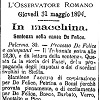
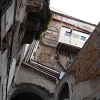
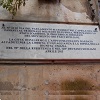
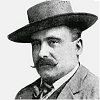
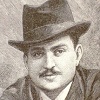
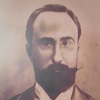
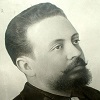
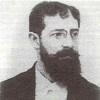
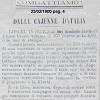
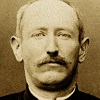
The bombs
of 1894
On the night of May
31st, 1894, two bombs exploded at the Ministry
of War (currently Minister of Defense) in via Firenze, on
the corner with via XX settembre, and at the Ministry of justice,
then in Odescalchi palace,
at the corner between vicolo del Divino Amore and piazza Borghese,
near Montecitorio palace (seat of the Parliament), where no person
were injured and little material damage were done (see news on
L'Osservatore romano). For
these attacks, the investigations were conducted by police delegate
(commissioner) Poli, notorious head of the Political Squad of
the police headquarters, headed by commendator Siro Sironi. On
1st June the police searched, without success,
the homes of Giovanni Forbicini, Giovanni Del Bravo, Umberto Faina,
Costantino Quaglieri and Geniberto Ammiraglia, but then arrested
them, citing responsibility for previous events (see Il
Messaggero of 2nd June, 1894). The newspaper refers
to a request from Prince Odescalchi, whose palace had been the
targett of one of the attacks: actually the member of Parliament
prince Baldassarre Odescalchi
had intervened on May 31st
in the Chamber of
Deputies to complain that the police had not obtained results
in the investigations on the bombs, calling into question the
Prime Minister and Minister of the Interior Francesco Crispi.
Il Messaggero
of June 3rd, 1894 reports the visit to the
newsroom of many pupils from the ornamental preparatory school
to protest against the arrest of their comrade Costantino Quaglieri,
vouching for their comrade's conduct and excluding his participation
in the attacks.
The same newspaper reported a further arrest for the bombs, of
the porter Vincenzo Orazi, and the persecution against another
suspect, the innkeeper Romolo Jacobini, known as "Romoletto",
on whom the Police Headquarters had forced the closure of his
tavern, putting his family in serious financial difficulties.
Death
in Regina Coeli
The sequence of events
that brought Quaglieri to death began when his friend and workmate
Giovanni Forbicini (1874-1955), an anarchist leader with origins
from Romagna called him as a witness on his behalf, since he was
investigated for the explosion of the two bombs of February 1893
at Tommasi Crudeli's and Ferri's houses. Forbicini had been referred
to the provincial commission for house arrest, which at the end
of the procedure acquitted him, as well as Quaglieri himself.
After six months of detention, the notorious "black book"
of the police headquarters laconically gave the news of Constantino's
death. According to the official version between 11:00 and 12:00
of 12th February, 1895, Quaglieri was
found hanged at the bars of the window of his cell, the number
4 of Regina Coeli intermediate wing, with
a towel joined with a handkerchief. He was rescued and laid down
on his plank bed, but he ceased to live shortly thereafter.
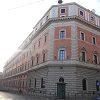
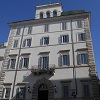
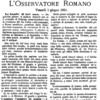
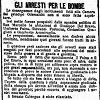

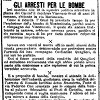
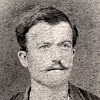
The press
The newspaper "Per la libertà" ("For
freedom") of February 14th, 1895, telling the story of Costantino
Quaglieri gave credit to the thesis of suicide with a towel, being
Costantino "impressed by his own physical deterioration
and moral breakdown" also remarked by his mother when
she visited him in prison. The newspaper, however, put the blame
for suicide to the harassment suffered in prison and concluded
the short news by writing: "To the Royal delegate Poli,
murderer of the most vulgar, the curse of all honest people".
Even the Vatican newspaper L'Osservatore
Romano briefly reported the news, attributing death
to suicide, which occurred for unknown reasons, while the Rome
newspaper Il Messaggero
reported the news of the death with the heading "L'impiccato
a Regina Coeli - Una vittima della polizia" ("The
man hanged in Regina Coeli - A police victim"). The newspaper
referred about rumors that instead justified the thesis of a murder
by the police, as shown in the title, and promised a closer examination
of the facts.
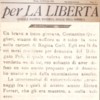
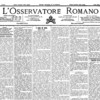
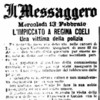
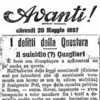
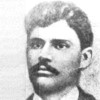
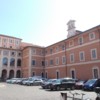
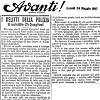
Avanti!
Just over two years
later, on May 20th, 1897, the Socialist newspaper
Avanti! resumed the case, which couldn't be able to deal
with at the time, given that the first issue of the newspaper
was published on December 25th, 1896. With a short
article the newspaper hardly questioned the hypothesis of
suicide, in conjunction with the controversies and investigations
on the death of the Socialist carpenter from Jesi Romeo
Frezzi (see my webpage on him)
murdered by the policeman in San Michele
a Ripa jail in Rome. Avanti! explained that Quaglieri's
mother had shuttled between the jail and the mortuary for two
days to see the body of her son, but she wasn't allowed to, they
hadn't told her if the autopsy had been performed, neither by
whom, and even less its outcome. In addition, according to the
Police Headquarters, Quaglieri would have written with his blood
on the cell wall the sentence: "Mi ammazzo, addio!"
("I take my life, farewell!"), but his mother
wasn't allowed to see the writing. According to the newspaper,
the motive for the murder was the revenge of delegate Poli against
Quaglieri, for defending Giovanni Forbicini, providing him a credible
alibi, given the seriousness of Quaglieri himself. However, shortly
after the young man's death, Poli had been transferred (Avanti!, May
20th, 1897, p. 3). Four days later Avanti! published
a new recall to the
case Quaglieri, with further details, reiterating doubts about
the alleged suicide, and confirming the thesis of revenge (Avanti!, May
24th, 1897, p. 2).
The improbable
suicide
According to Il
Messaggero of February 13th, the day before his death Quaglieri
had met his mother and his sisters Francesca and Cecilia, to whom
he had appeared calm and not giving any hint of dejection that
could lead him to take his life. Costantino told his mother that
"when he was released, he would have wanted to erase by
so many kisses and caresses the wrinkle of tears dug by his arrest
". Moreover, Constantino was aware that his family needed
his material help and would not deprive him of his support.
Constantino's
brothers
In the register of Regina Coeli jail in Rome, at number 10648,
a brother of Costantino, Ettore Quaglieri, was reported as arrested
on September 14th, 1894 at 6:20 AM. He was born
in Arpino in 1879, and therefore he was fifteen, he lived in Rome
in viale Margherita, 20, he was a locksmith by trade, non-propertied
and catholic, arrested the day before for violation of articles
258 and 263 of Criminal Code. Article 258 punished those who spent
or anyway put false currency into circulation. Article 263 equalized
public credit cards to currency, in particular those with legal
tender status as currency, bearer bond coupons with status of
negotiable securities and all other legal tender or commercial
certificates issued by institutions authorized to issue them.
Ettore was sentenced to four months and twenty days of imprisonment
on May 17th, 1893, including the period he
served from April 21st to May 21st,
1893, and consigned to the Carabinieri on October 14th,
1894 to serve the rest of the sentence in the Frascati jail. The
mildness of the verdict suggests that Ettore had received the
fake currency in good faith (penalty of up to six months according
to article 258) and not in a malicious manner (penalty from 1
to 7 years or from 3 to 10 years in the most serious cases).
Another data sheet from the register, bearing no number, concerns
the same Ettore, with the same arrest date of September 13th
and the same date of entry into prison, but at 8:00PM instead
of at 6:20AM, reporting his domicile again in Viale Margherita,
but at number 300 instead of 20, with the charge of "spending
fake banknotes" instead of indicating the articles of
the Criminal Code.
Another Costantino's brother who appears in the registers of the
prison of Regina Coeli is Cicerone, born in 1880, living in Viale
Margherita 306, painter by trade (in Rome this term also means
a construction painter), who was arrested on December 2nd,
1894, then at the age of fourteen, for theft and two days later
he entered Regina Coeli. The boy was released on December 12th
of the same year so as not to proceed, on the orders of the Royal
Prosecutor.
Similarities
Costantino Quaglieri
died while in law enforcement custody, as happened two years later
to Romeo Frezzi, in 1901 to the anarchist regicide Gaetano
Bresci (see my webpage on him),
in 1903 to the Sicilian sailor Giacomo
D'Angelo (see my webpage
on him), in 1930 to the young Calabrian communist Rocco
Pugliese (see my webpage on
him), and to the anarchist railway worker Giuseppe
Pinelli, thrown from a window of the Milan police headquarters
on December 16th, 1969.
On Costantino Quaglieri's case apparently no investigation was
started, no policeman was investigated, indeed, the names of the
guards involved were not even published, and only the delegate
Poli was transferred.
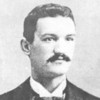
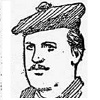
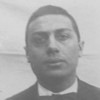

Memory
Costantino Quaglieri was buried on February 13th
in the "new sector" in Campo Verano
cemetery of Rome, with a ceremony to which the authorities admitted
only family members. The anarchist newspaper "Combattiamo!"
("Let's fight!") of February 25th,
1900 gave an account of a private conference commemorating Costantino
Quaglieri, held on 11th February, on the anniversary
of his death, but which from the brief report seems to have been
centered above all on controversies between anarchists and socialists.
During the conference, a speech was delivered by lawyer Francesco
Saverio Merlino, which six months later, on August 29th,
1900, defended Gaetano Bresci (see my
webpage on him) in the trial for the regicide of Umberto
I.
In the socialist-anarchist newspaper L’Agitazione
of February 7th, 1902 an obituary in memory of
Costantino's suicide, was published, while on
the same journal of December 19th, 1902 Titus (Tito Lubrano) remembered
him as having killed himself in Regina Coeli.
Ten years after his death, on February 3rd,
1905, the Germinal group, in agreement with the Quaglieri family,
launched a
subscription to exhume and cremate Constantino's body. A burial ceremonies
committee was also formed. The socialist-anarchist federation
of Lazio called
a demonstration for the transport of the ashes to the municipal
cinerary, also to celebrate a more well-attended funeral compared
to that of 1895. The federation's statement also asked for clarification
on the real circumstance of Costantino's death. On February 19th,
1905 an unauthorized
march moved from Porta Tiburtina to the Campo Verano cemetery
where the body was cremated and the urn with the ashes, bearing
the number 1137, was transported
by his companions to the municipal cinerary, located inside the
cemetery itself, where speeches were given by Michele Pulcini
for the socialists, Pietro Gibertoni for the republicans and Giovanni
Forbicini for anarchists. Costantino's mother was present and
emotionally thanked the participants.
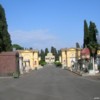
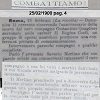
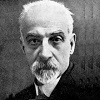
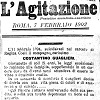
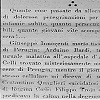
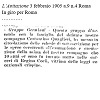
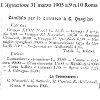
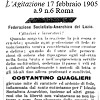
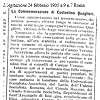
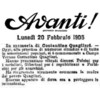
A socialist-anarchist
group from the Borgo-Prati districts was named after Constantino,
which according to a report from the Prefecture already existed
in March 1906. The "Costantino Quaglieri" group
presented to the Italian Anarchist Congress in Rome on 16th-20th
June, 1907 the motion “Gli anarchici e il movimento antimilitarista”
("The anarchists and the anti-militarist movement"),
and published an article with the same title in the newspaper
"Il Pensiero" ("The Thought")
of July 1st, 1907. The group, on February
17th, 1907, the 307th anniversary of the murder of
Giordano Bruno, edited the publication
of the special issue "Per
Giordano Bruno : la parola dei liberi" ("For
Giordano Bruno: the talk of free men") (link).
In addition, the group participated in the protests against the
visit of Tsar Nicholas II to Italy,
and together with others signed the document “Contro la
venuta dello zar” ("Against the coming of the
tsar"). The emperor, given the high risk of unrest due
to the protests of the Roman citizens, was forced to give up the
visit to the capital, and arrived by
train from France, welcomed by king Vittorio
Emanuele III. The two sovereigns on October 23rd,
1909 together reached Racconigi
castle near Turin, where they signed a bilateral treaty.

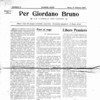

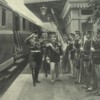

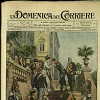
BIBLIOGRAPHIC REFERENCE:
AdS
- Archivio di Stato di Roma - succursale di via Galla Placidia
- Fondo "Carceri giudiziarie romane (1870-1929)". BP54
e BP57.
BADON Cristina (2018) Gli anarchici romani nella crisi di fine
XIX secolo: una storia da riscoprire. Storia e Futuro, Numero
48, dicembre 2018. link
BISCIONE
Francesco Maria (1987) De Felice Giuffrida, Giuseppe. Dizionario
Biografico degli Italiani - Volume 33. link
CODICE PENALE per il Regno d'Italia. Stamperia Reale, Roma,
1889. Pubblicato a cura dell'Università degli Studi di
Brescia, Facoltà di Giurisprudenza.
DA PASSANO Mario (2005) Il «delitto di Regina Cœli».
Diritto e Storia, n.4 - In memoriam - Da Passano link
FORBICINI
Giovanni (1910) Memorie di uno sciagurato. Libreria Editrice
Libertaria, Roma.
GRELLA Pasquale (1987) Appunti per la storia del movimento
anarchico romano dalle origini al 1946. De Vittoria, Roma
LISANTI Francesco (2014) Apologia di Gaetano Bresci. Booktime,
Milano.
MASINI Pier Carlo (1981) Storia degli anarchici italiani nell'epoca
degli attentati. Rizzoli, Milano.
PER LA LIBERTÀ (1895) anno I, n. 6, 14 febbraio 1895, p.4.
Websites visited:
Anarchopaedia
- item "Giovanni Forbicini" - link
Wikipedia
- item "Giovanni Forbicini" - link
Biblioteca
Libertaria Armando Borghi - link
Giovanni
Forbicini (vida y obra) - link
Il libro
del passato - link
Isole nella
rete - link
Per Giordano
Bruno - Biblioteca Franco Serantini - link
Digital Library
of the Italian Senate of the Republic (Avanti!) - link
Digital collection
of journals of the Biblioteca Nazionale Centrale di Roma (Il
Messaggero)
Digital collection of journals of the Biblioteca di Storia Moderna
e Contemporanea di Roma (La Domenica del Corriere)
Digital collection of journals of the Biblioteca della Pontificia
Università Gregoriana (L'Osservatore Romano)
Italian Chamber of Deputies - Parliament proceedings - XVIII
Legislature - 1st session - discussions - round of 31st May, 1894 - p.
9564 link
Archives visited:
Rome
State Archive (Archivio di Stato di Roma) - succursale di via
Galla Placidia
National Central Library of Rome (Biblioteca Nazionale Centrale
di Roma)
Library of Modern and Contemporary History (Biblioteca di Storia
Moderna e Contemporanea di Roma)
Library of Lelio e Lisli Basso Foundation, Rome (Biblioteca della
Fondazione Lelio e Lisli Basso - Roma) (Per la Libertà)
Law Central Library, Rome (Biblioteca Centrale Giuridica - Roma)
Municipal Library Guglielmo Marconi, Rome (Biblioteca Comunale
Guglielmo Marconi - Roma)
 page
created: June
21st, 2020 and last updated: March 15th, 2024
page
created: June
21st, 2020 and last updated: March 15th, 2024